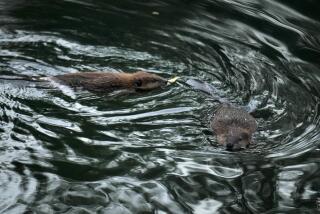Herons, Frogs, Rabbits Turn Elementary School Into a Zoo
- Share via
ANAHEIM — It was not a scene that lent itself to school decorum. At least not at Riverdale Elementary, where students are supposed to behave, teachers are expected to teach and the study of wildlife is usually reserved for the pages of textbooks.
But there it was, a baby heron of all things, squawking and running through the campus like some kind of teen-ager on the last day of school.
“I turned around and all of a sudden there was this very loudly squawking bird running through the office with my secretary and the librarian running behind her,” said Connie Pezoldt, summer term principal at Riverdale, where 105 students are enrolled.
According to Pezoldt, every day at Riverdale is like a trip to the zoo. The heron, it turns out, was just the latest uninvited visitor to the Anaheim campus recently.
The school’s grounds this year have been alive with wild yellow canaries and starlings and rabbits running around a Quonset hut in the back. A couple months back, the school secretary found a cockatiel in the parking lot and brought it home as a pet.
And then there were the frogs, tiny ones, hundreds of them, so many that they carpeted the playground this spring.
Try keeping the kids in line when frogs are running around the schoolyard like so many ants. The frogs became so popular, in fact, that many K-6 graders adopted them as their own, putting them in their pockets and anywhere else they would fit. Teachers had to practically “frisk students for frogs,” Pezoldt said. Frogs were confiscated from desks, lunch pails and pockets.
One year when the frogs returned in April, Pezoldt added, they were so thick “the grass was jumping,” and teachers could barely open their classroom doors without sweeping a dozen tiny toads out of the way.
The campus, she said, is “like a live science project daily.”
Located across the street from Riverdale Park in east Anaheim and less than a quarter of a mile from the Santa Ana River, the school seems to be an ideal heronry.
“With the river real close and being in close proximity to Anaheim Hills where there’s a lot of undeveloped land, we are in a prime spot for seeing all kinds of things,” Pezoldt said.
School custodian Bob Hicks had a more evolutionary theory: each spring the frogs swim from the Santa Ana River through the sewer system and the herons and starlings soon follow.
“They just love frogs,” Hicks pointed out.
The herons appeared about a year after the frogs first took over the Riverdale playground four years ago.
The baby heron in Pezoldt’s office last week was one of dozens of the long-legged birds that favor nesting in the tall trees on the Riverdale campus, just a short flight from the nearby Santa Ana River.
The birds sunbathe in trees that have up to 10 nests, sitting on the tips of branches that look too thin to hold their large bodies. Bits of fish and crab claws litter the ground beneath.
“When you get a whole bunch of them up there in the trees it sounds like teen-agers having a party,” said Hicks, who often has to pick up after the messy birds. Nearby, a dun-colored young heron high-stepped into the safety of some oleander bushes.
“I like to watch them play,” said Robby Giovino, 9, one of the students. “I heard one that sounded like he was trying to play the horn but he was pushing the wrong key.”
Herons, noted for their pointed bills and long necks and legs, often nest near marshy fresh or saltwater areas and feed on fish, frogs and crustaceans.
Riverdale is not always a garden of Eden, however. Hicks has discovered about 30 dead herons on school grounds in recent months--baby birds that have fallen from the nest or adults that were losers in territorial battles.
“I pick ‘em up before the kids get here. Otherwise they pick ‘em up and bring ‘em to their teacher,” he said.
The debris the birds leave behind can also become a health hazard if not quickly disposed of, Pezoldt said.
Many herons nest--and lunch--directly above the kindergarten yard and the students are fascinated with their leftovers.
“We’d have little kindergartners walking around with dead fish saying ‘Eeeeuuuww, look what I found!’ ” Pezoldt said.
But the herons are here to stay, Pezoldt said. At least for now, the frogs are gone. But they are not forgotten.
Librarian Carolyn Pierce recently found the dehydrated remains of a grown frog that had “got lost in the Dewey Decimal System.”
She put him in a box and temporarily stashed it on a bookshelf above a copy of “From the Mixed Up Files of Mrs. Basil E. Frankweiler.”
Then there was the time she discovered a healthy little toad had made its way to the library. She placed it in a dish, dug out a few books and welcomed a class of second- through fourth-graders to observe it.
They talked about how tadpoles became frogs and about how you must be careful not to squeeze a small toad too hard. The lessons were fleeting.
“The boys still wanted to put (the frogs) in their pockets and throw them on girls and all the ornery things you can think of,” Pierce said.
More to Read
Sign up for Essential California
The most important California stories and recommendations in your inbox every morning.
You may occasionally receive promotional content from the Los Angeles Times.













